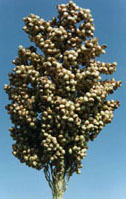| DESCRIPTION: Summer annual, coarse, erect with much variability in growth characteristics; culms solid or sometimes with spaces in pith, 0.6ˆ5 m tall, depending on variety and growing conditions, 5 to over 30 mm in diameter, either dry at maturity or with sweet insipid juice; leaves broad and coarse, similar in shape to those of corn but shorter and wider; blades glabrous and waxy; sheaths encircle culm and have overlapping margins; panicle erect, sometimes recurved, usually compact in most grain sorghums and more open in forage types; seed covered by glumes that may or may not be removed by threshing; prop roots may grow from culm nodes; bud at each node from which a tiller may grow; seeds white, yellow, red, or brown; panicle with up to 6,000 spikelets. Seeds 25,000 to 61,740/kg. USES: Grown for grain, forage, syrup and sugar, and industrial uses of stems and fibers. Grain sorghum is a staple cereal in hot dry tropics, the threshed grain ground into a wholesome flour. Stalks used as animal feed. Important summer fodder where temperatures are high and rainfall insufficient for corn. Most important for silage or green soiling, or for hay when grown irrigated in very dry areas. FURTHER INF.: Ranging from Cool Temperate Steppe to Wet through Tropical Thorn to Wet Forest Life Zones, sorghum is reported to tolerate annual precipitation of 2.0 to 41.0 (mean of 86 cases = 10.9), annual temperature of 7.8 to 27.8°C (mean of 86 cases = 20.1), and pH of 4.3 to 8.7 (mean of 69 cases = 6.7). Adapted to tropical and subtropical summer rainfall climate with rainfall from 25ˆ125 cm annually; of little importance in more humid areas with higher rainfall. Some cvs are short-day plants. Adapted to wide range of soils varying from light loams to heavy clays; thrives best on light, easily worked soils of high fertility, with moderate to high available water, with erosion not a problem. Moderately well-drained soils are suitable for sorghums. Small amounts of alkali in sand reduces performance considerably. Tolerance to salinity is moderate. Prefers moderately acid soil; pH down to 5.7 does not drastically affect production. |
